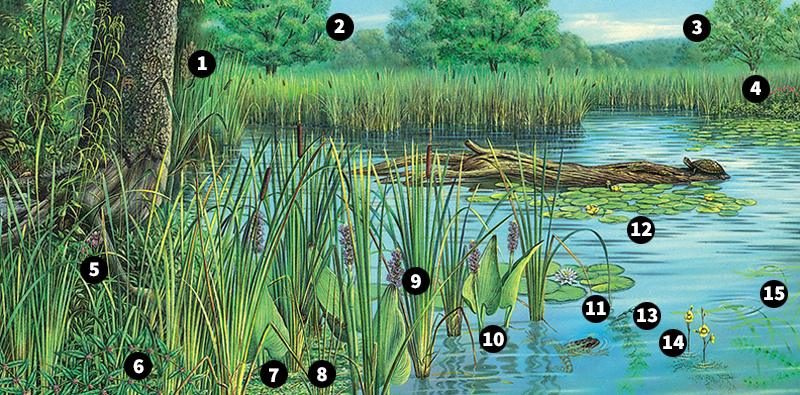Pond is a small, quiet body of water that is usually shallow enough for sunlight to reach the bottom. The sunlight enables rooted plants to grow across a pond bottom from shore to shore.
Ponds have a great variety of animal and plant life. In fact, ponds are as important as rivers and lakes in the support they provide to living things. Pond animals include birds, crayfish, fish, frogs, insects, newts, snails, and turtles, among other animals. Many ponds have rooted plants that either grow entirely underwater or have parts that extend above the surface. Microbes also thrive in ponds. New life is brought to ponds by the wind, by streams, and by waterbirds that carry eggs, seeds, or small animals.
Pond life.
The life found in a pond is determined largely by the pond’s soil, quality of water, and location. Tropical ponds have different species (kinds) of plants and animals than ponds in the Arctic, in mountains, or in prairies. Temporary ponds support specialized plants and animals that can survive cycles of drying and flooding.

Ponds undergo annual and long-term changes. Water levels rise and fall because of rainfall. As water levels change, plant growth also changes. As the numbers and types of plants change, some animals may become numerous, while others may decline.
Many natural processes help to maintain ponds. For example, floods and the movement of ice may deepen ponds. But ponds are vulnerable to damage because they are relatively small. For example, when people dump garbage or other wastes into a pond, its quality rapidly deteriorates.
Kinds of ponds.
Ponds may be formed by natural conditions or by human beings. The chief kinds of natural ponds include alpine ponds, bog ponds, ice-formed ponds, meadow-stream ponds, riverine ponds, sinkhole ponds, and tundra ponds. People build ponds for flood control or recreation, to secure a supply of water, or to remove pollution from the water through the action of plants.
Alpine ponds
are gouged out by glaciers in mountainous regions. Many are located in the Alps in Europe and the Rocky Mountains in the United States.
Bog ponds
form worldwide, but especially in low-lying places in cooler regions of the Northern Hemisphere. These ponds contain much peat and peat moss. The water of bog ponds has a high acid content.
Ice-formed ponds
were created during prehistoric times by moving sheets of ice. The scraping action of these ice sheets created many basins that became ponds.
Meadow-stream ponds
develop where a slowly moving stream widens as it flows over a gently sloping landscape. Most meadow-stream ponds contain abundant life.
Riverine ponds
develop where streams have stopped flowing through old channels. These ponds also occur where soil prevents water from entering channels.
Sinkhole ponds
develop in regions with much limestone underground. If water dissolves the limestone, the ground sinks and a pond may form.
Tundra ponds
form in regions that have permafrost (permanently frozen ground). In such regions, areas of thawed ground may become ponds.
